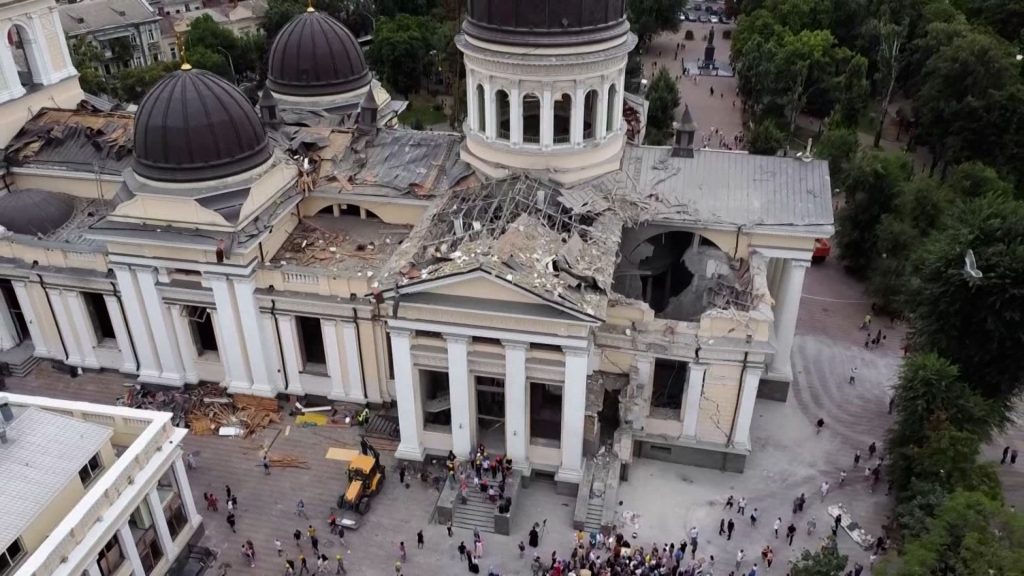In the wake of the recent Russian attacks on Odesa, a strategic port city on the Black Sea, UNESCO is preparing to conduct a field mission to assess the damages caused to the city’s architectural landmarks. Among the affected structures is the historic Transfiguration Cathedral, which holds significant cultural and religious value. The attacks have raised concerns about the preservation of Odesa’s rich cultural heritage, prompting international aid efforts and potential consequences for those responsible.
The Transfiguration Cathedral
A Treasured Landmark The Transfiguration Cathedral, originally completed in 1808 by the Italian architect Francesco Frappoli, is one of Odesa’s most renowned architectural landmarks. Despite being destroyed during conflicts with Joseph Stalin’s regime in 1936, the cathedral was rebuilt in the 2000s. However, the recent Russian attacks have inflicted further damage on this treasured site, sparking concerns about its preservation and restoration.
Odesa Diocese’s Efforts to Preserve Icons
In the aftermath of the attacks, the Odesa diocese shared heartbreaking video footage of city residents sifting through the rubble of the cathedral, desperately trying to salvage religious icons and artifacts. The destruction of the Transfiguration Cathedral has deeply affected the local community, highlighting the need for urgent action to safeguard cultural heritage in the region.
Conflicting Claims and Accountability
Russia’s Ministry of Defense has denied targeting the cathedral, stating that their military focus was solely on “military and terrorist infrastructure of the Kyiv region.” They attributed the damage to a stray defense missile fired by Ukrainian forces. However, the Ukrainian military command in Odesa has referred to the attack as “the largest blow of the enemy across the historic center of the city of Odesa since the beginning of the war.” The conflicting claims add to the complexities of identifying responsibility and ensuring accountability for the damages incurred.
Odesa’s Appeal for UNESCO’s Protection
Last October, Ukrainian President Volodymyr Zelenskyy made a formal appeal to UNESCO to place Odesa’s city center under its protection. Such a move would not only attract international aid but also bring potential consequences for those involved in the destruction of the city’s cultural heritage. As a crossroads for European and Asian cultures, Odesa boasts an array of architectural landmarks, including the Odesa Opera House and the Tolstoy Palace.
UNESCO’s Efforts to Preserve Odesa’s Cultural Heritage
The July 2022 aerial assault on Odesa led to the destruction of parts of the Odesa Museum of Modern Art and Odesa Museum of Fine Arts. In response, UNESCO provided funding for the repairs of both museums and supported initiatives to digitize artworks and provide protective equipment. However, the Odesa Museum of Fine Arts had to relocate most of its 12,000-work collection for safekeeping by its employees in February, emphasizing the urgent need for preservation efforts amidst ongoing conflicts.
Conclusion
The recent attacks on Odesa’s architectural landmarks, including the Transfiguration Cathedral, have raised alarm over the preservation of the city’s rich cultural heritage. As UNESCO prepares to assess the damages, the international community is coming together to support restoration efforts and hold those responsible accountable for the destruction of this historical crossroads of cultures. It is crucial to protect and safeguard Odesa’s cultural treasures for future generations and ensure their resilience in the face of adversity.
Feature Image: The damage to historic Ukrainian cathedral after Russian strikes. Courtesy: CNN

Contributor





